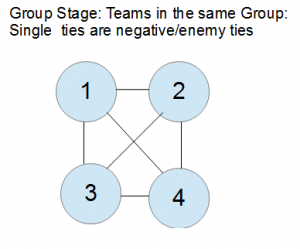Networks in the League of Legend’s Championship Tournament
League of Legends is the premier MOBA-game for PCs. Ever since its inception in 2009, it has taken over the gaming scene by storm. Approximately 7 million gamers play daily. Unlike most other games, it requires real-time strategy as it pairs five gamers together to fight another team: 5 vs. 5. Indeed, it is evident that each group of players are forced into a complex network in which they have allies and enemies. However, in the professional e-sports scene, pro-players have dedicated gaming-houses and long practice and scriming sessions in which they strengthen their ties within their own team’s ‘network’. Looking at network of players within a team facing another, the network is structurally balanced. Any triangle of three nodes drawn has either the case of 3 allied players (3 + ties), or 2 allied players and 1 enemy player (2 – ties and 1 + tie). Both cases are structurally balanced, and this creates a fair play situation in which players on the same team have no incentive to ‘troll’ their own teammates by switching sides or refusing to help teammates. (The game requires strict cooperation to win.) The upcoming World’ Championship, to be held in Germany, with a $2.1 million prize pool, features the top three teams from North America, Europe, Korea, China, and the International Wildcard regions.
The World’s championship is split into two parts: the group stage and the knockout/bracket stage. In the group stage, teams are placed into one of four groups in which they face off in a double round-robin against others in their same group. The biggest rule to this is that groups cannot have more than one team per region. Therefore, two North American teams cannot be placed into the same group. If we create a network based on pro-teams instead of the players themselves, we can draw allied-ties between pro-teams in the same region, as they have a strong sense of regional pride. Due to this group stage format, the network becomes structurally balanced as there can never be two allied-pairs in the same group. Instead, the network in each group is all enemy ties or at most one allied tie, and two enemy ties. Teams then have no incentive to ‘not try as hard’ in the group stage in hopes of getting a certain seeding during the bracket stage. This pool randomization and selection rule was brought about after last year’s World’s Championship controversy in which well-performing teams would thought to have purposely ‘thrown’ games in order to not face a harder opponent in the bracket stage. Due to the randomness in groups, and balance of the tournament-network, pro-teams are now incentivized to perform at their best at all stages of the game, creating a much better environment for game integrity. This year’s League of Legend’s World Champion is yet to be decided, but the tournament format has been mechanized well with network balance in mind.

Sources:
http://na.lolesports.com/articles/guide-2015-group-draw
http://na.lolesports.com/articles/2015-world-championship-format
